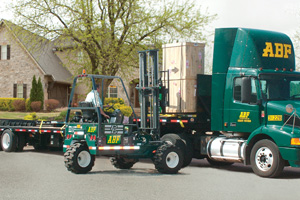Home Deliveries: Changing Consumer Habits Lead to New Fleet Services

This story appears in the Aug. 1 print edition of Transport Topics.
Online shopping and do-it-yourself customers have increased the number of residential deliveries trucking companies make. And because many customer purchases come in large, often unwieldy, packages and crates, executives from carriers and equipment manufacturers say they have discovered that adding the right equipment to their trucks allows fleets to do more deliveries in less time and with fewer vehicles.
Estes Express Lines is targeting residential deliveries with its new E-Street Direct division, which specializes in first-to-final mile business-to-customer and business-to-business service. Estes Express has six E-Street Direct logistics centers across the United States that serve as anchors for the delivery network.
“A change in consumers’ buying behaviors, driven by technology and its ease of use, is at the heart of this initiative,” said Leslie Thrift, spokeswoman for Estes Express, which is based in Richmond, Va., and ranks No. 17 on the Transport Topics Top 100 list of the largest U.S. and Canadian for-hire carriers.
A large factor in the purchase of new delivery equipment is the type of service required by the customer. These offerings include curbside, threshold, room-of-choice and turnkey services.
Thrift told Transport Topics that Estes Express — which provides curbside, threshold and room-of-choice services — has invested in a fleet of vehicles that are conducive to residential and specialized deliveries, rather than utilizing its standard less-than-truckload equipment. In addition to liftgates, the company uses Moffetts — three-wheeled, truck-mounted forklifts that attach to the back of a trailer.
Estes Express deliveries include appliances, furniture, exercise equipment, bedding and home-improvement items such as grills and lawn mowers, Thrift said, adding that the carrier also helps with debris removal and installations.
“The concept of a truck-mounted forklift means that, as a fleet owner, you’re in control of your delivery. The benefit to the consumer — the customer’s customer — is that the goods are being delivered straight to the point where he wants them, so he doesn’t have to handle them,” said Patrick Keenan, director of truck-mounted forklifts for Moffett-manufacturer Cargotec.
Moffetts, which cost between $35,000 and $45,000, are secured underneath the bed of the truck with a mounting kit that costs about $1,500, Keenan said. For greater flexibility, multiple vehicles can be fitted with the mounting kits, which can be used on flatbed trailers, beverage trailers and single-axle trucks among others, he added.
ABF Freight System — a unit of Arkansas Best Corp., which is based in Fort Smith, Ark., and ranks No. 14 on the for-hire TT 100 — uses Princeton Delivery Systems’ PiggyBack truck-mounted forklifts to offload large items and place them on a customer’s property.
“A vertical lift is another useful delivery tool. These are enhanced hand trucks that enable the driver to place heavy pieces on shelves or countertops,” said ABF Freight System spokesman Russ Aikman.
He added, “With consumers shifting increasingly away from brick-and-mortar retailers in favor of online purchases, we believe this industry segment will continue to grow.”
Despite the specialized equipment, carriers agreed that liftgates — platforms installed on the back of trucks that can raise and lower shipments — remain the workhorse of residential deliveries.
Each of Con-way Freight’s 310 service centers has at least one 28-foot dry van trailer equipped with a liftgate, and the carrier has more than 1,000 in its fleet.
Con-way uses two different types of liftgates — the tuck-away style stored underneath the trailer behind the rear axle — and one that is in front of the trailer door.
“Tuck-under is the more preferred. If there is a malfunction with the other one, you can’t get into the trailer,” said Paul Lorensen, vice president of operations for Con-way Freight, a unit of Ann Arbor, Mich.-based Con-way Inc., which ranks third on the TT 100 for-hire list.
Pitt Ohio, No. 65 on the TT 100 for-hire list, uses tuck-away liftgates manufactured by Maxon Lift Corp., Santa Fe Springs, Calif., and Waltco Lift Corp., Tallmadge, Ohio. About 35% of Pitt Ohio’s fleet is equipped with liftgates, said Geoff Muessig, executive vice president.
To find the right liftgate for its needs, Pitt Ohio interviews the shipper and its consignees — the people at home waiting for their deliveries — to better understand the commodity, freight handling characteristics and the delivery site constraints, Muessig said.
Waltco offers around 50 different standard models, ranging in capacity from 1,250 pounds to 6,600 pounds. To help carriers find the right product, the company offers an online liftgate selection tool where users input the type of vehicle, bed height of the vehicle, overall width of the truck or trailer, description of the cargo and any material-handling devices used.
“Fleets need to fully understand their delivery process — side door/rear door, capacity, duty cycle, dock loading requirements, etc. — and how liftgates could aid or improve safety and productivity,” said Scott Ickes, a spokesman for Waltco.
Anton Griessner, vice president of marketing and business development for Maxon, said the liftgate manufacturer has 15 different basic products — and there are hundreds of ways those products can be customized.
Maxon’s liftgates have a dedicated battery pack, and Griessner advised carriers to look closely at liftgate battery-charging options to make sure they have enough power to conduct all their deliveries.
“In this context, it is important to understand how many deliveries, how much time between stops to recharge batteries, etc.,” he said.
Mark Stein, director of operations services for Central Freight Lines, Waco, Texas, said the fleet spends between $6,000 and $9,000 for each liftgate it purchases, plus another $1,000 to $1,500 to install each one. The carrier’s liftgates can hold anywhere from 2,500 to 5,500 pounds and last seven to 10 years, if maintained properly.
“As with any mechanical device, there is a suggested regular maintenance schedule. Because the liftgates are more mechanical in nature, they do have to be looked after more than a door would,” Stein said.
He said the right equipment also can help maximize efficiency.
“With the right equipment on the right routes, you can prevent the driver from having to manually unload two skids of freight. That can take 45 minutes to an hour longer. If you have that [liftgate] on there, you can accomplish it in a five-to-10 minute time frame,” Stein said.
In addition to obtaining the right equipment, carriers should seek out drivers committed to giving consignees a great customer-service experience, said Aidan Oliver, director of corporate operations for AIT Worldwide Logistics, Itasca, Ill.
“When you’re doing home delivery, you’re not dealing with transportation professionals. You’re dealing with people’s personal space, and they have high expectations. Everybody involved in that process has to be sensitive to that,” he said.
To ensure a smooth delivery, customers need to relay accurate expectations of the delivery service the carrier is providing to the consignees, Oliver said.
“It can put drivers in a very uncomfortable situation if it is curbside delivery, and the person wants it in the home,” he said.
And according to CFL’s Stein: “The expectations from the customer in a commercial environment is that you bring it to my dock and you leave it there. In a residential area, the customer is going to want it at a doorstep and not at the driveway.”
Carriers are bound by their customers’ requests, but exceeding their normal practices increases their liability, Oliver said.
“If the driver goes above and beyond just trying to be a nice guy, we’ve taken on the liability. The customer is only liable for what they’ve requested from us,” he said.
Con-way’s Lorensen said the company specifically trains drivers on how to speak to the customer — and what will generate additional cost.
Given the challenges drivers may face with residential deliveries, many carriers said they focus on training. For example, ABF creates training modules for drivers doing white-glove inside delivery as part of ABF’s turnkey service, which includes the unpacking, assembly and placement of a product. To ensure drivers can follow the proper procedures for specific products, ABF said it requires a sample shipment at its general office, which it uses to create an online training module.
ABF said its turnkey deliveries include fitness equipment, flat-screen televisions and upscale bedroom furniture.
Residential deliveries can create some additional planning challenges, carriers said.
“Most of your commercial zones are in the same area, but you might have to drive seven miles to a residential area. If you add five or six residential stops, you’re adding a lot of driving distance,” Stein said.
What’s more, carriers try to work around consignees’ schedules as much as possible.
“The reality in these days and times is both adults work, so usually it is a situation where we either meet them at lunch time or it gets loaded into the nose of the trailer and it is the last delivery a driver makes,” Con-way’s Lorensen said.
CFL relies on early morning deliveries and deliveries on the weekends.
“Those things add to the cost because as you constrain the normal delivery flow on that route,” Stein said.
To help keep productivity in check, CFL uses software to monitor that cost of each shipment.
AIT’s residential deliveries take place on weekends because “consignees are at home. There is less traffic on the road, so drivers can get more deliveries done in a row and there are mostly only residential deliveries to do on the weekend,” Oliver said.
In addition to liftgates, the logistics company has invested in furniture dollies and clamp forklifts, which it uses for more fragile items because “the arms are on the side of the forklift and you put a little pressure on the side to lift it that way,” Oliver said.
Consumer electronics make up the largest percentage of AIT’s home deliveries, but the carrier also delivers furniture, exercise equipment, appliances and sun porches.
Drivers may have to alter their routes to comply with regulations that ban heavy-duty trucks from some residential streets. Lorensen said it is the in-bound planner’s responsibility to be aware of any regulations restricting truck access.
“It may be a situation where instead of putting a traditional tractor and trailer on that route, we’ll use a straight truck,” he explained.
Carriers agreed that communication throughout the entire life cycle of the shipment is critical for customer satisfaction.
AIT has an online appointment system that is tied directly to its capacity-management system. Consignees can go online and schedule their delivery based on which zip codes AIT is covering during certain times of the day or days of the week.
AIT said its home deliveries soared to 219,047 in 2010 from 48,526 in 2009 — a 351% increase. Oliver said that number should increase again in 2011, adding that the company is already up about 26% year over year.
Even companies that aren’t specifically seeking out residential deliveries are seeing growth in the segment.
“People are ordering more from factories and having goods delivered to their doorstep,” Stein said. “I think we’ll continue to see an increase.”
Digital research firm comScore Inc. wrote in its State of the U.S. Online Retail Economy report that, with the exception of 2009, e-commerce has grown from 7% to 29% annually since 2003.
While carriers have reported success with residential deliveries, the service comes with increased risk. Narrow streets, low-hanging wires and landscaped yards can create hurdles, as does working around the schedules of consignees.
“When you look at the challenges of driving in a residential area, they go up dramatically compared to a commercial area,” Stein said. “If a driver is not completely aware of his surroundings, he can get himself into trouble from a safety standpoint.”
Oliver told TT, “Home delivery is not something you dip your toe into. You have to be committed to it because there are a lot of obstacles.”




